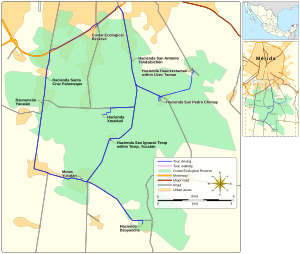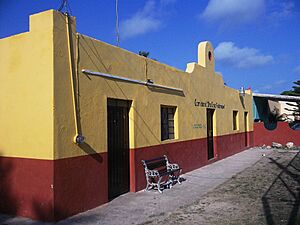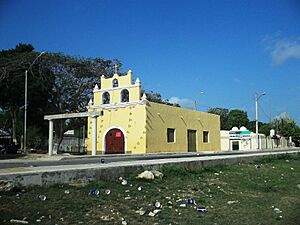Hacienda Santa Cruz Palomeque facts for kids
Quick facts for kids
Hacienda Santa Cruz Palomeque
|
|
|---|---|
|
Hotel
|
|

Entry
|
|

Cuxtal Ecological Reserve
|
|
| Country | Mexico |
| Mexican States | Yucatán |
| Municipalities | Mérida Municipality |
| Time zone | UTC−6 (CST) |
| • Summer (DST) | UTC−5 (CDT) |
| Postal code |
97315
|
| Area code | 999 |
Hacienda Santa Cruz Palomeque is a special place in southeastern Mexico. It's located in the state of Yucatán, near the city of Mérida. This hacienda was built during a time when a plant called henequen was very important for making ropes. Today, it's part of the Cuxtal Ecological Reserve. This reserve helps protect both nature and old buildings around Mérida.
Contents
What's in a Name?
The name Santa Cruz Palomeque has two parts. "Santa Cruz" means holy cross in Spanish. This part refers to a religious group called the Brotherhood of the Holy Cross. "Palomeque" is the last name of one of the hacienda's past owners, José María Palomeque. He also owned a part of another hacienda called Hacienda Chenkú.
How to Visit
This hacienda is located south of Mérida. To get there, you can take the Periférico road south. Look for the exit marked "Dzununcan, Avenida 86." Turn towards Dzununcan and drive for about 1 kilometer.
A Look Back in Time
The land where Hacienda Santa Cruz Palomeque now stands was once a Franciscan monastery back in 1640. Later, it became a farm that grew henequen. José María Palomeque was one of the owners who ran the henequen farm.
On June 28, 1993, the Cuxtal Ecological Reserve was created. Its goal was to protect the history of seven large haciendas, along with their nearby villages. It also protects 12 smaller archaeological sites, 6 natural pools called cenotes, and an important water source for Mérida. Hacienda Santa Cruz Palomeque was included in this special protected area.
Within the Cuxtal Ecological Reserve, these haciendas are protected:
- Hacienda Hunxectamán
- Hacienda San Antonio Tahdzibichén
- Hacienda San Ignacio Tesip
- Hacienda San Nicolás Dzoyaxché, which has a cenote called Dzonot-Ich
- Hacienda San Pedro Chimay
- Hacienda Santa Cruz Palomeque
- Hacienda Xmatkuil
In 2007, Robert and Carolyn Franck bought the hacienda. It had been left empty for some time. They fixed it up and brought it back to life. Today, Hacienda Santa Cruz Palomeque is a beautiful hotel. People can also rent it for private events like weddings.
Amazing Architecture
The hacienda covers an area of 7 hectares, which is about 17 acres. It has several buildings, large gardens, and parts of older structures. Stone walls surround the entire area, and big trees provide lots of shade.
The Main House
The Main House was built in an old colonial style. Its stone walls are very thick, about 1.8 meters (6 feet) wide! The floors are also made of stone. The ceilings are very high, and there are large arches in the hallway. These arches were big enough for horse-drawn carriages to pass through.
The Powerhouse
During the time when henequen was processed, the powerhouse was the most important building. This is where the sisal fiber from the henequen plant was turned into strong ropes. Today, the powerhouse has been changed into a bar and a place for guests to check in. You can reach it from a courtyard below by climbing a library staircase.
The Chapel
The chapel at the hacienda was badly damaged by Hurricane Gilberto in 1988. But it has been completely fixed and looks beautiful again. A special carved wooden beam that supported the old roof was saved and put back in place. The chapel is now used for religious services like Masses, baptisms, and weddings.
People of the Hacienda
Before 1937, many people lived and worked on the henequen farms. But in 1937, a new law changed things. President Lázaro Cárdenas made a rule that turned the haciendas into collective farms called ejidos. This meant that the land was shared by the community. The old landowners could only keep about 150 hectares (about 370 acres) for their private use.
After 1937, the Hacienda Santa Cruz Palomeque mostly housed only the owner's family. The numbers below show how the population of the area changed over the years.
According to a count done in 2005 by INEGI, the population of the area was 718 people. This included 372 men and 346 women.
| Year | 1900 | 1910 | 1921 | 1930 | 1940 | 1950 | 1960 | 1970 | 1980 | 1990 | 1995 | 2000 | 2005 |
|---|---|---|---|---|---|---|---|---|---|---|---|---|---|
| Population | 7 | 0 | 17 | 154 | 106 | 155 | 220 | 202 | 276 | 374 | 419 | 567 | 718 |
Images for kids
See also
 In Spanish: Santa Cruz Palomeque para niños
In Spanish: Santa Cruz Palomeque para niños





